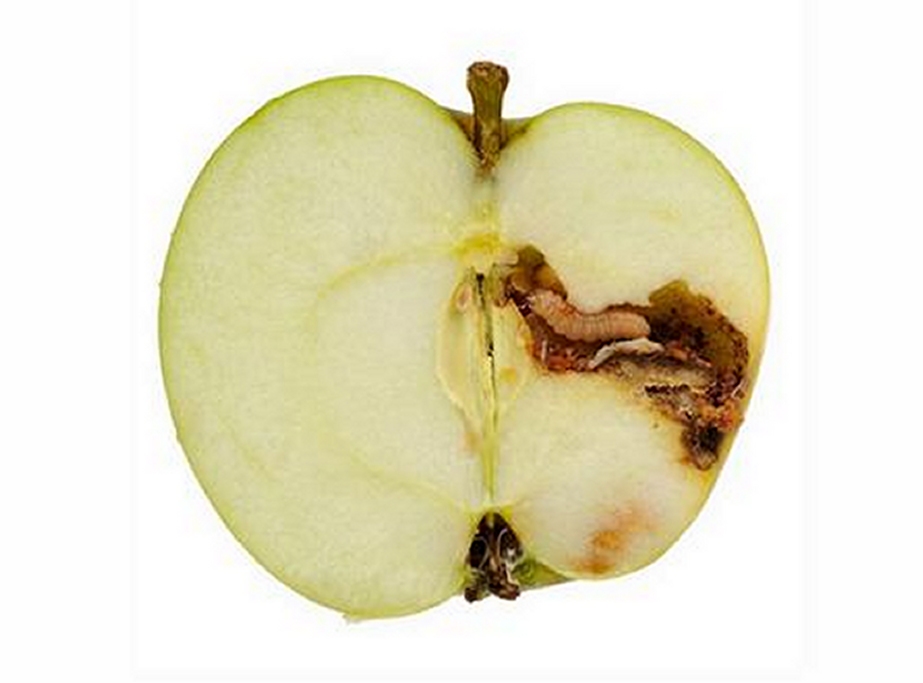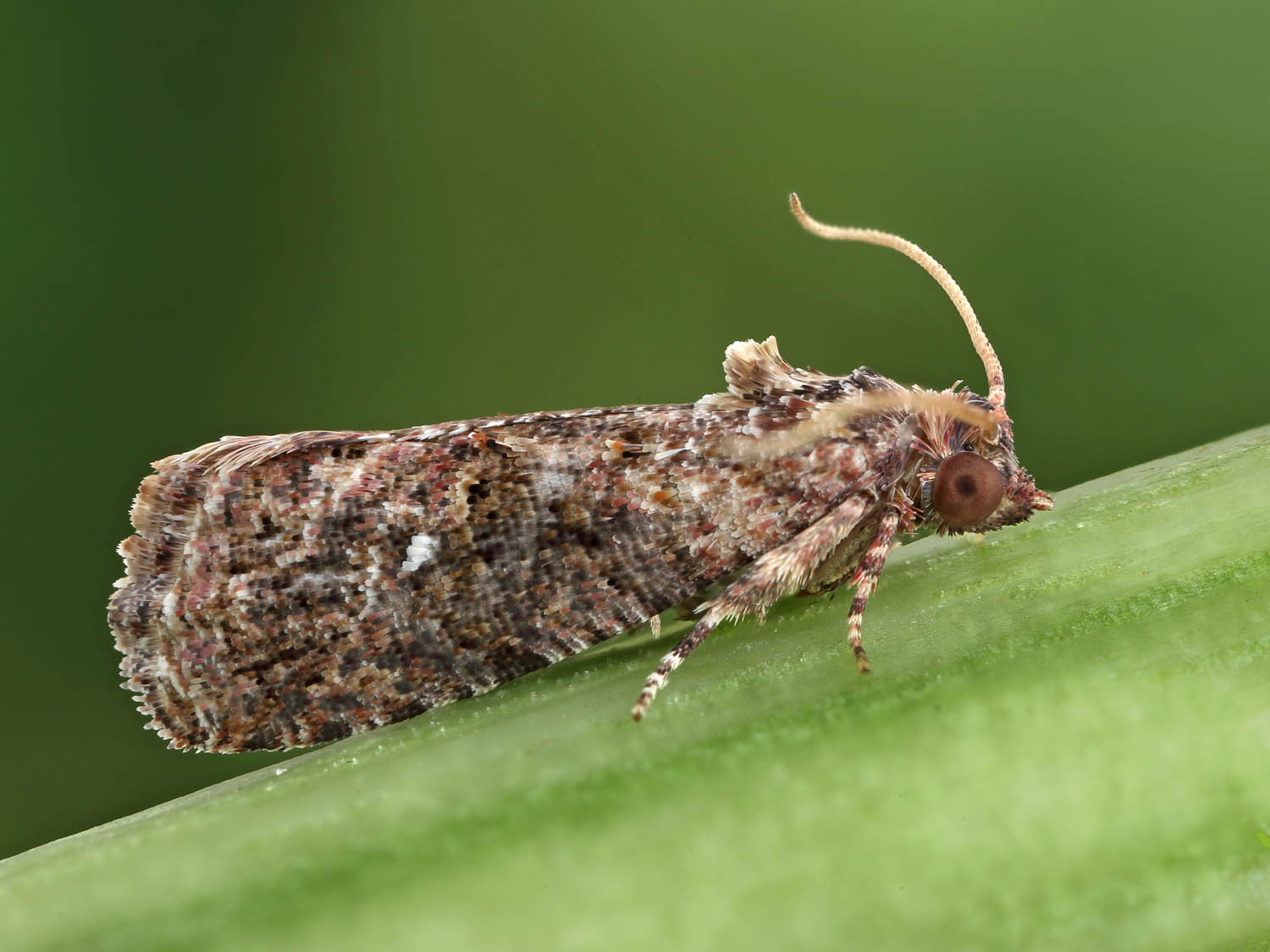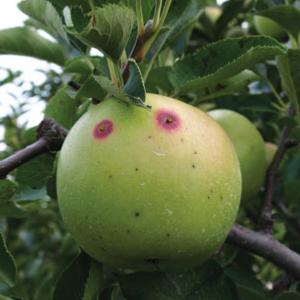
Carpocapsa
Cydia Pomonella
Pathogène :
Insect
Type:
Risque:
CRITICAL
Polillas




QUI EN EST LA CAUSE ?
Cydia pomonella, commonly known as the codling moth, is an insect belonging to the Tortricidae family. Adults are small, with a wingspan of approximately 18 mm, and have dark gray forewings with lighter wavy lines and a dark brown spot. Females lay their eggs individually on fruits or leaves. The eggs are white and oval in shape, hatching in about 6 to 10 days. The larvae, pinkish white in color with a black head, quickly enter the fruits to feed on the pulp and seeds. The larva goes through five stages before leaving the fruit to pupate in the soil or in the bark of the tree. Pupation occurs in a silk cocoon, and depending on weather conditions, development from pupation to emergence of the adult can take several weeks. Cydia pomonella can have two to three generations per year in warm climates.
SYMPTÔMES
In the apple tree, codling moth causes significant damage that affects both the quality and yield of the crop. The larvae pierce the fruits to feed on the seeds and pulp, causing internal damage that reduces the commercial quality of the apples.
- Appearance of small holes on the surface of the apples.
- Presence of excrement and sawdust around the entrance holes.
- Internal damage to the fruits, with tunnels and cavities full of excrement.
- Premature fall of affected fruits.
- Reduction in the commercial value of apples.
- Increased susceptibility to secondary infections due to fungi and bacteria.
TEMPÉRATURE ET HUMIDITÉ
20-30°C
60-80%
VOIES DE TRANSMISSION
Wind, movement of infected fruits, contaminated agricultural tools, nursery material, direct contact between plants
TRAITEMENTS
Traitements chimiques
• (E,E)-8,10-DODECADIEN-1-OL 0.4g/diffuser + DODECAN-1-OL 0.2g/diffuser [VP] P/P
• (E,E)-8,10-DODECADIEN-1-OL 1100mg/diffuser [VP] P/P
• (E,E)-8,10-DODECADIEN-1-OL 14.18% (300mg/diffuser) [VP] P/P
• (E,E)-8,10-DODECADIEN-1-OL 18.05% [AE] P/P
• (E,E)-8,10-DODECEN-1-OL 18.05% + Mixture of: [(E)-8-DODECEN-1-YL ACETATE + (Z)-8-DODECEN-1-YL ACETATE+ (Z)-8-DODECEN-1-OL] 12.5% [AE] P/P
• (E,E)-8,10-DODECEN-1-OL 19.5% + (Z)-8-DODECEN-1-IL ACETATE 13.1% + (E)-8-DODECEN-1-IL ACETATE 0.75% + Z-8-DODECEN-1-OL 0.1% [AE] P/P
• (E,E)-8,10-DODECADIEN-1-OL 20.9% [AE] P/P
• (Z)-11 TETRADECEN-1-IL ACETATE 11.4% + (Z)-9- TETRADECEN-1-IL ACETATE 6.3% + (E,E)-8,10-DODECADIEN-1-OL 16 .9% [AE] P/P
• 1-TETRADECANOL 7.1% (31 MG S.A./DIFFUSOR) + DODECAN-1-OL 29.7% (132 MG S.A./DIFFUSOR) + E,E-8,10-DODECADIEN-1-OL 57.3% (254 MG S.A./DIFFUSER) [VP] P/P
• ACETAMIPRID 20% [SL] P/V
• CYPERMETHRIN 10% [EC] P/V
• CHLORANTRANILIPROL 20% [SC] P/V
• DELTAMETHRIN 1.5% [EW] P/V
• DELTAMETHRIN 1.57% [SC] P/V
• DELTAMETHRIN 10% [EC] P/V
• DELTAMETHRIN 2.5% [EC] P/V
• DELTAMETHRIN 2.5% [EW] P/V
• E,E-8,10-DODECADIEN-1-OL 0.798% (10.63 MG S.A./DIFFUSER) [VP] P/P
• E,E-8,10-DODECADIEN-1-OL 14% (3.35 X 10E-7 G I.A./CAPSULE) [CS] P/V
• E,E-8,10-DODECADIEN-1-OL 18.05% [AE] P/P
• E,E-8,10-DODECADIEN-1-OL 2.4% [VP] P/P
• E,E-8,10-DODECADIEN-1-OL 4.6% [VP] P/P
• E,E-8,10-DODECADIEN-1-OL 7.75% [VP] P/P
• E,E-8,10-DODECADIEN-1-OL 9.03% [AE] P/P
• EMAMECTIN BENZOATE 0.95% [WG] P/P
• ESFENVALERATE 2.5% [EC] P/V
• ESFENVALERATE 5% [EC] P/V
• ESFENVALERATO 5% [EW] P/V
• LAMBDA CYHALOTHRIN 1.5% [CS] P/V
• LAMBDA CYHALOTHRIN 10% [CS] P/V
• LAMBDA CYHALOTHRIN 2.5% [WG] P/P
• LAMBDA CYHALOTHRIN 5% [EG] P/P
• SPINETORAM 25% [WG] P/P
• SPINOSAD 48% [SC] P/V
• TEBUFENOCIDE 24% [SC] P/V
• CYDIA POMONELLA ATTRACTANT (Cairomonal attractant)
• Cydia pomonella (Pheromone)
Traitements autorisés en agriculture biologique
• (E,E)-8,10-DODECADIEN-1-OL 0.4g/diffuser + DODECAN-1-OL 0.2g/diffuser [VP] P/P
• (E,E)-8,10-DODECADIEN-1-OL 1100mg/diffuser [VP] P/P
• (E,E)-8,10-DODECADIEN-1-OL 14.18% (300mg/diffuser) [VP] P/P
• (E,E)-8,10-DODECADIEN-1-OL 18.05% [AE] P/P
• (E,E)-8,10-DODECEN-1-OL 18.05% + Mixture of: [(E)-8-DODECEN-1-YL ACETATE + (Z)-8-DODECEN-1-YL ACETATE+ (Z)-8-DODECEN-1-OL] 12.5% [AE] P/P
• (E,E)-8,10-DODECEN-1-OL 19.5% + (Z)-8-DODECEN-1-IL ACETATE 13.1% + (E)-8-DODECEN-1-IL ACETATE 0.75% + Z-8-DODECEN-1-OL 0.1% [AE] P/P
• (E,E)-8,10-DODECADIEN-1-OL 20.9% [AE] P/P
• (Z)-11 TETRADECEN-1-IL ACETATE 11.4% + (Z)-9- TETRADECEN-1-IL ACETATE 6.3% + (E,E)-8,10-DODECADIEN-1-OL 16 .9% [AE] P/P
• 1-TETRADECANOL 7.1% (31 MG S.A./DIFFUSOR) + DODECAN-1-OL 29.7% (132 MG S.A./DIFFUSOR) + E,E-8,10-DODECADIEN-1-OL 57.3% (254 MG S.A./DIFFUSER) [VP] P/P
• E,E-8,10-DODECADIEN-1-OL 0.798% (10.63 MG S.A./DIFFUSER) [VP] P/P
• E,E-8,10-DODECADIEN-1-OL 2.4% [VP] P/P
• E,E-8,10-DODECADIEN-1-OL 4.6% [VP] P/P
• LAMBDA CYHALOTHRIN 1.5% [CS] P/V
• LAMBDA CYHALOTHRIN 10% [CS] P/V
• LAMBDA CYHALOTHRIN 2.5% [WG] P/P
• LAMBDA CYHALOTHRIN 5% [EG] P/P
• SPINOSAD 48% [SC] P/V
• CYDIA POMONELLA ATTRACTANT (Cairomonal attractant)
• Cydia pomonella (Pheromone)
Traitements biologiques
• BACILLUS THURINGIENSIS AIZAWAI 50% [WG] P/P
• BACILLUS THURINGIENSIS KURSTAKI (ABTS-351 strain, 640 g/kg) (32 MILLION CLU/g) 64% [WP] P/P
• BACILLUS THURINGIENSIS KURSTAKI (ABTS-351 strain) (32 MILLION CLU/g) 54% (540 g/kg) [WG] P/P
• BACILLUS THURINGIENSIS KURSTAKI (ABTS-351 strain) (32 MILLION CLU/g) 54% [WG] P/P
• BACILLUS THURINGIENSIS KURSTAKI (ABTS-351 strain) 54[WG] P/P
• BACILLUS THURINGIENSIS KURSTAKI (STRAIN PB 54) (16x10E6 I.U./G) 8% [WP] P/P
• BACILLUS THURINGIENSIS KURSTAKI (STRAIN PB 54) (16x10E6 IU/G) 9.74% [SC] P/V
• BACILLUS THURINGIENSIS KURSTAKI (STRAIN PB 54) 32% (32 MILLION IU/G) [WP] P/P
• BACILLUS THURINGIENSIS KURSTAKI (Strain SA-11) 85% (32 MILLION IU/G) [WG] P/P
• CYDIA POMONELLA GRANULOVIRUS (MEXICAN ISOLATE) (2x10E13 viable granules/L) 4.96% [SC] P/V
• CYDIA POMONELLA GRANULOVIRUS (MEXICAN ISOLATE) 90.9% (1X10e13 GRANULES/L) [SC] P/V
• CYDIA POMONELLA GRANULOVIRUS (R5 ISOLATE) 90.9% (1 X 10E13 GV/L) [SC] P/V
• CYDIA POMONELLA GRANULOVIRUS (CpGV V15) (3 X 10E13 GRANULES/L) 52% [SC] P/V
• CYDIA POMONELLA GRANULOVIRUS (CpGV V22) (3 X 10E13 GRANULES/L) 52% [SC] P/V
• STEINERNEMA FELTIAE (Parasitoid and predatory nematodes)
Recommandations
- Monitor the crop regularly using pheromone traps to detect the presence of adults.
- Implement biological control through the release of natural enemies such as Trichogramma spp.
- Apply treatments with selective insecticides at critical moments of pest development.
- Maintain good hygiene in the field, eliminating and destroying fallen fruits and pruning remains.
- Use protective nets around trees to prevent oviposition.
- Promote the use of apple tree varieties that are resistant or less susceptible to infestation.
- Carry out a crop rotation to interrupt the life cycle of the pest.
- Apply sexual confusion treatments with pheromones to reduce moth mating.
- Promote a favorable environment for the natural predators of the codling moth by diversifying plants in the field.
- Avoid excessive use of insecticides so as not to affect the pest's natural enemies.
TRAITEMENTS
Remèdes maison
There are no home treatments
Alliés naturels
Traitements chimiques
There are no treatments for this disease. Treatments are directed at the insect vectors that transmit it. See insect treatments.
RECOMMANDATIONS
- Check the back of the leaves frequently, especially in dry weather.
- Spray water on the leaves to increase humidity and prevent them from settling.
- Keep plants healthy with good watering and adequate light.
- If you see cobwebs or damage, clean the leaves with a damp cloth or pressurized water.
- Use potassium soap or neem oil every few days until they disappear.
Plantes répulsives
Rosemary, Dill, Coriander
PRODUITS RECOMMANDÉS
*Les traitements recommandés sont des recommandations basées sur les bases de données des autorités et ne remplacent en aucun cas les lignes directrices établies par la législation de chaque pays.
*Les produits présentés sont des recommandations et ne sont pas nos propres produits. En tant qu'associés Amazon, nous gagnons des revenus grâce aux achats de produits recommandés.





















